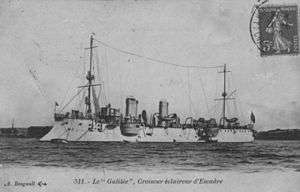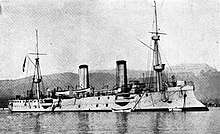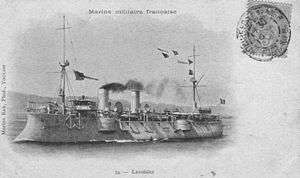Linois-class cruiser
The Linois class was a class of protected cruisers of the French Navy. The class comprised Linois, Galilée and Lavoisier.
 Galilée at anchor sometime before 1909 | |
| Class overview | |
|---|---|
| Name: | Linois class |
| Builders: | |
| Operators: |
|
| Preceded by: | Friant class |
| Succeeded by: | Descartes class |
| Built: | 1892–1898 |
| In commission: | 1895–1920 |
| Completed: | 3 |
| Retired: | 3 |
| General characteristics | |
| Class and type: | Protected cruiser |
| Displacement: | 2,285 to 2,318 long tons (2,322 to 2,355 t) |
| Length: | 98 m (321 ft 6 in) loa[lower-alpha 1] |
| Beam: | 10.62 m (34 ft 10 in) |
| Draft: | 5.44 m (17 ft 10 in) |
| Installed power: |
|
| Propulsion: |
|
| Speed: | 20.5 knots (38.0 km/h; 23.6 mph) |
| Complement: | 250–269 |
| Armament: |
|
| Armor: |
|
Design
In response to a war scare with Italy in the late 1880s, the French Navy embarked on a major construction program in 1890 to counter the threat of the Italian fleet and that of Italy's ally Germany. The plan called for a total of seventy cruisers for use in home waters and overseas in the French colonial empire. The Linois class were ordered as part of the program,[1][2] and their design was based on the earlier Forbin class, albeit with increased freeboard.[3][4]
General characteristics and machinery

The ships of the Linois class varied slightly in dimensions; Linois was 98 m (321 ft 6 in) long overall, while Lavoisier and Galilée were 100.63 m (330 ft 2 in) long. Linois and Lavoisier had a beam of 10.62 m (34 ft 10 in), while Galilée was slightly wider, at 10.97 m (36 ft). All three ships had a draft of 5.44 m (17 ft 10 in). They displaced 2,285 to 2,318 long tons (2,322 to 2,355 t). Like most French warships of the period, the Linois-class cruisers' hulls had a pronounced ram bow and tumblehome shape. They also had a short forecastle deck , and the hulls included a double bottom. The ships had a minimal superstructure, with a small conning tower and a bridge forward and a smaller, secondary bridge aft. They were fitted with pole masts with spotting tops for observation and signaling purposes. Their crew varied over the course of their careers, amounting to 250–269 officers and enlisted men.[3][5]
The ships' propulsion system consisted of a pair of vertical triple-expansion steam engines driving two screw propellers. Steam was provided by six coal-burning fire-tube boilers for Linois, while the other two vessels received sixteen coal-fired, Belleville-type water-tube boilers. All of the ships' boiler rooms were ducted into two funnels. Their machinery was rated to produce 6,800 indicated horsepower (5,100 kW) for a top speed of 20.5 knots (38.0 km/h; 23.6 mph). Coal storage amounted to 400 long tons (410 t) for Linois and 339 long tons (344 t) for Lavoisier and Galilée.[3] They had a cruising radius of 3,000 nautical miles (5,600 km; 3,500 mi) at 10 knots (19 km/h; 12 mph) and 600 nmi (1,100 km; 690 mi) at 20.5 knots.[6]
Armament and armor
._Pi%C3%A8ce_de_100_de_marine_-_Fonds_Berthel%C3%A9_-_49Fi1270_(cropped).jpg)
The ships were armed with a main battery of four 138.6 mm (5.5 in) 45-caliber guns in individual pivot mounts with gun shields, all in sponsons located amidships with two guns per broadside.[3] These were probably the M1893 variant installed without trunnions. They fired a variety of shells, including solid, 30 kg (66 lb) cast iron projectiles, and 35 kg (77 lb) explosive armor-piercing (AP) and semi-armor-piercing (SAP) shells with a muzzle velocity of 730 to 770 m/s (2,400 to 2,500 ft/s).[7] The forward pair were placed just abaft the conning tower and the after pair were between the aft funnel and the main mast. The main battery was supported by a pair of 100 mm (3.9 in) Modèle 1891 guns, one at the bow and the other at the stern, which were also fitted with shields.[3] The guns fired 14 kg (31 lb) cast iron and 16 kg (35 lb) AP shells with a muzzle velocity of 710 to 740 m/s (2,300 to 2,400 ft/s).[8]
For close-range defense against torpedo boats, they carried eight 47 mm (1.9 in) 3-pounder Hotchkiss guns, two 37 mm (1.5 in) guns, and four 37 mm Hotchkiss revolver cannon. These were carried in individual pivot mounts and they were distributed along the length of the ship to provide wide fields of fire. All three ships were also armed with four 450 mm (17.7 in) torpedo tubes in their hull above the waterline. The torpedoes were the M1892 variant, which carried a 75 kg (165 lb) warhead and had a range of 800 m (2,600 ft) at a speed of 27.5 knots (50.9 km/h; 31.6 mph).[3][9] Linois and Galilée had provisions to carry up to 120 naval mines.[3]
Armor protection consisted of a curved armor deck that was 40 mm (1.6 in) thick. Above the deck at the sides, a cofferdam filled with cellulose was intended to contain flooding from damage below the waterline. Below the main deck, a thin splinter deck covered the propulsion machinery spaces to protect them from shell fragments. Their forward conning towers had 138 mm (5 in) thick plating on the sides. The gun shields for the main battery were 75 mm (3 in) thick, while the secondary guns received 50 mm (2 in) thick shields.[3]
Construction

| Name | Laid down[3] | Launched[10] | Completed[3] | Shipyard[3] |
|---|---|---|---|---|
| Linois | August 1892 | 30 January 1894 | 1895 | Société Nouvelle des Forges et Chantiers de la Méditerranée, La Seyne-sur-Mer |
| Galilée | 1893 | 28 April 1896 | September 1897[11] | Arsenal de Rochefort, Rochefort |
| Lavoisier | January 1895 | April 1897 | April 1898 | Arsenal de Rochefort, Rochefort |
Service history

Footnotes
Notes
- Figures are for Linois
Citations
- Ropp, pp. 195–197.
- Gardiner, pp. 310–311.
- Gardiner, p. 310.
- Dorn & Drake, p. 49.
- Dorn & Drake, p. 50.
- France, p. 33.
- Friedman, p. 224.
- Friedman, p. 225.
- Friedman, p. 345.
- Gardiner & Gray, p. 193.
- Service Performed, p. 299.
References
| Wikimedia Commons has media related to Linois class cruisers. |
- Dorn, E. J. & Drake, J. C. (July 1894). "Notes on Ships and Torpedo Boats". Notes on the Year's Naval Progress. Washington, D.C.: United States Office of Naval Intelligence. XIII: 3–78. OCLC 727366607.
- "France". Notes on the Year's Naval Progress. Washington, D.C.: United States Office of Naval Intelligence. XV: 27–41. July 1896. OCLC 727366607.
- Friedman, Norman (2011). Naval Weapons of World War One: Guns, Torpedoes, Mines and ASW Weapons of All Nations; An Illustrated Directory. Annapolis: Naval Institute Press. ISBN 978-1-84832-100-7.
- Gardiner, Robert, ed. (1979). Conway's All the World's Fighting Ships 1860–1905. London: Conway Maritime Press. ISBN 978-0-85177-133-5.
- Gardiner, Robert & Gray, Randal, eds. (1985). Conway's All the World's Fighting Ships: 1906–1921. Annapolis: Naval Institute Press. ISBN 978-0-87021-907-8.
- Meirat, Jean (1975). "Details and Operational History of the Third-Class Cruiser Lavoisier". F. P. D. S. Newsletter. Akron: F. P. D. S. III (3): 20–23. OCLC 41554533.
- Ropp, Theodore (1987). Roberts, Stephen S. (ed.). The Development of a Modern Navy: French Naval Policy, 1871–1904. Annapolis: Naval Institute Press. ISBN 978-0-87021-141-6.
- "Service Performed by French Vessels Fitted with Belleville Boilers". Notes on Naval Progress. Washington, D.C.: United States Office of Naval Intelligence. 20: 299. July 1901. OCLC 699264868.